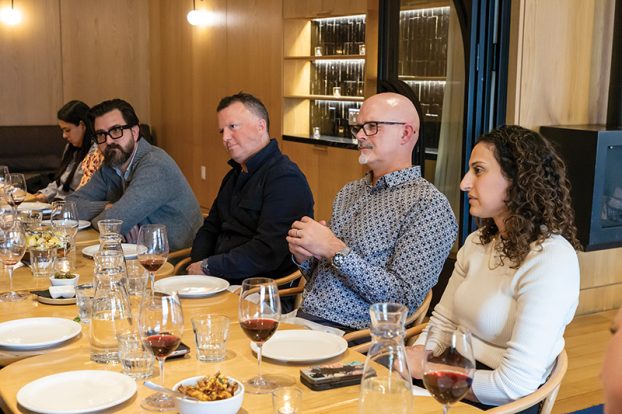It’s getting pretty crowded on your tv dial.
In addition to the conventional stations, there are now more than 30 specialty services available in Canada, all clamouring for a share of the viewer’s attention.
Not surprisingly, building network brands has become an increasingly high priority for broadcasters. That’s especially true in the specialty arena. Few of the cable channels can boast what you’d call must-see programming, so an appealing brand personality can prove key to luring viewers.
One advantage that a specialty service does have when it comes to branding is (in most cases, anyway) a clearly defined programming niche – unlike conventional stations, which must by nature be all things to all people.
For this report, Strategy’s David Todd asked several specialty broadcasters how they have dealt with the branding challenge.
Showcase Television
‘There will come a time,’ warns Janet Eastwood, ‘when people will be able to choose to get only the channels they want. And specialty channels need to be poised for that point.’
While this prospect may still be some distance in the cable future, it was nevertheless one of the considerations that led Showcase Television to launch its newest image campaign.
‘We have to make sure people realize that they need Showcase on their shortlist,’ says Eastwood, the channel’s vice-president, marketing and communications.
Among the crop of specialty services that launched in 1995, Showcase has proven a strong player, with its mix of critically acclaimed movies and outstanding series from around the world, such as Oz and Cracker. But Eastwood says that when she came on board in 1997, it was clear that the channel lacked brand equity.
‘People were watching the programs, but could not articulate what Showcase is,’ she says.
Research indicated that the channel has two strengths in the eyes of viewers: the international nature of its programming, and the fact that all movies and shows air uncut. From this insight came Showcase’s new positioning statement: ‘Television without borders.’
Toronto agency Harrod & Mirlin/FCB was brought in to develop the brand campaign, which broke in major markets early in August. The ads ran for six weeks, in outdoor, print, radio and television.
The creative executions employed lines such as ‘Think Oz is an ’80s metal band?’ and ‘Think Cronenberg is a trendy German beer?’ to underline in viewers’ minds the type of programming associated with Showcase.
The channel’s target audience, Eastwood says, consists of ‘urban sophisticates.’ (Approximately 70% of viewers are from Toronto and Vancouver.) So the tone of the campaign was designed to establish a brand personality that would be ‘hip, edgy, provocative and energetic.’
The results so far suggest that its aim was true. According to Eastwood, prime-time audiences are up 60% since August – an increase that she attributes both to the campaign and to the decision to start airing two feature films a night.
With so many viewing choices available today, Eastwood says, specialty channels must brand themselves well, so that audiences understand precisely what they offer. But branding efforts must be undertaken with care. (Showcase, for example, flirted with the possibility of a name change, but quickly dropped the idea when research pointed in the other direction.)
‘There’s a risk associated with any branding initiative,’ she says. ‘You have to be careful that what you brand around doesn’t alienate your existing viewer base.’
Space/MuchMoreMusic
Yeah, you could say David Kirkwood knows a thing or two about network branding.
In the past two years, after all, he has been intimately involved in the launch of CHUM Television’s two new specialty channels, Space and MuchMoreMusic, as vice-president, sales and marketing for both.
Building brands from scratch for services like these is undeniably a challenge. The approach at chum, Kirkwood says, is to start by creating a tag line for a station, and then treating that as a mission statement.
‘Branding starts with that tag line,’ he explains. ‘It becomes the guiding light when we think about program acquisitions, scheduling, interstitial programming and station promos. We do everything we can to be the tag line.’
In the case of Space, which made its debut in October 1997, the line is ‘The Imagination Station’ – a choice that reflects the channel’s desire to be seen as more than a haven for reruns of schlocky sci-fi series and old bugs-from-outer-space movies.
Kirkwood says the station’s goal is to present the full spectrum of science fiction and science fact – from contemporary series like The X-Files to reality programming on space exploration and the paranormal. So when crafting promos, ads, interstitials and other branding vehicles, Space is careful to eschew the kind of cheesy, retro imagery many associate with the sci-fi genre.
The stylized galaxy that dominates the Space logo is a perfect fit, he says, in that it reflects both the focus of the channel and the broad-based nature of its programming. ‘It’s an image that makes all things possible.’
As for MuchMoreMusic (tag line: ‘Great Music on Television’), the challenge has been to differentiate its brand from that of MuchMusic, while taking advantage of its sister station’s brand equity.
Like its u.s. counterpart VH1, MuchMoreMusic offers an easy-to-swallow cocktail of adult contemporary music for the 35-54 crowd. The station, which launched in the fall, aims to please viewers who are receptive to music television, but have outgrown youth-oriented MuchMusic and want nothing to do with all that scary rap music.
The channel’s promos, interstitials and overall visual identity all underline the brand character, Kirkwood says: smooth and easygoing, but still hip (in an elegant way).
For both Space and MuchMoreMusic, brand extensions have helped further their goals. Two Space cds have been released in the past few months (one of them the collected song stylings of William Shatner and Leonard Nimoy). And MuchMore has enjoyed considerable success with a double cd of its own. ‘They give us additional profile,’ Kirkwood says.
The Weather Network
So you need a quick hit of weather information. What are your options?
Well, you could always do as our ancestors did, and just look out the window. Or, if that seems a little low-tech, you can switch on your radio or tv, and consult one of the many sources available.
The folks at The Weather Network would, naturally enough, like to be your first choice for weather info. Which is why the channel has lately embarked upon a major branding initiative.
Billboards and transit shelter ads created by Toronto agency Holmes & Lee began appearing at the end of December (see Out-of-Home report, page 19). A 30-second tv spot is also airing on a number of specialty channels.
As a provider of weather information, the network faces increasing competitive pressure, both from other specialty services such as CBC Newsworld and CTV News 1, and from local broadcasters, many of which have invested heavily in improved weather coverage.
‘We have to step up our brand and improve awareness,’ says Rick Ridgway, the network’s senior vice-president and general manager. ‘It’s a necessary stage in our evolution.’
According to Ridgway, The Weather Network brand stands for accuracy, reliability and dependability. Hence the billboard with the arrow pointing to the sky, and the line that reads, simply, ‘Told you so.’ Or the transit shelter that boasts, ‘We know what you’ll be wearing tomorrow.’
‘We’re just trying to reinforce with people that we are the authoritative source for weather information,’ Ridgway says.
At the same time, the use of humour is meant to lend the brand a personable quality that it has, perhaps, heretofore lacked. That’s most evident in the tv spot, in which a trailer park denizen dozes off during a Weather Network report on a nearby tornado, and awakens later to find himself surrounded by munchkins.
‘We just want to get outside the box and give the network a little more personality than people are accustomed to,’ Ridgway says.
YTV
If the stuff you’re seeing on ytv these days seems a little weird…well, that’s the general idea.
With competition in the kids’ programming arena growing increasingly intense, the 10-year-old youth channel decided it was high time for a brand overhaul. The rallying cry for the initiative, which launched in the fall, is ‘Keep it Weird.’
Research has shown that kids delight in goofy, out-there humour, explains Susan Mandryk, vice-president of marketing for ytv. So the goal of the network’s re-branding effort has been to make the ytv name synonymous with weirdness.
‘We’ve really taken the notion of weird to our soul,’ Mandryk says. It permeates every aspect of the channel – from its current program lineup, to its recent print and outdoor advertising campaign, to its station ids and interstitial programming (talking Elvis heads, anyone?), to its promos for upcoming shows. (‘It’s amazing what you can do with Lassie,’ Mandryk says.) It even influenced the latest redecoration of the ytv offices.
‘We came out of the gate with a very careful approach, but we’re encouraged by the response we’ve had, so we’re turning up the level of weirdness,’ Mandryk says. ‘At the same time, we’re trying to make sure it doesn’t go over to the dark side. It should be funny weird, not creepy weird.’
Brand extensions such as the new magazine ytv whoa!, scheduled to launch in May, will also have a weird spin, she promises. (In addition to the magazine, there are now ytv-branded toys on the market, and a series of ytv-approved software titles. Plans for a line of kids’ apparel and a number of ‘interactive snack’ products are also in the works.)
As anyone involved in youth marketing will be quick to affirm, kids are alarmingly fickle in their enthusiasms. Mandryk, however, says that ytv’s new brand positioning should prove immune to such sudden shifts in young tastes.
‘Weird is not a trend or a fad,’ she says. ‘It’s an integral part of kids’ lives. So you can make it change with the times.’
Also in this report:
– Low-concept shows spell high ratings: Sitcoms about a gay/straight couple, a blue-collar single mom and a group of long-haired teens have climbed to the top of the fall TV heap p.B3
– A few successes, lots of bombs: Five media experts offer their takes on the current season p.B6
– No clear winner in Quebec ratings race: While TQS gets down and dirty, SRC and TVA duke it out for the high ground p.B12























